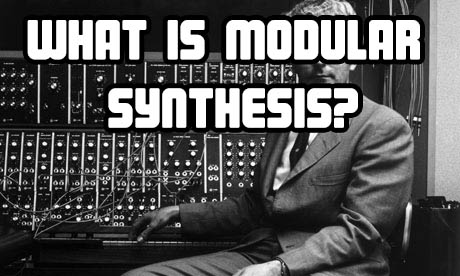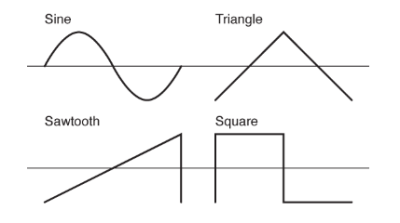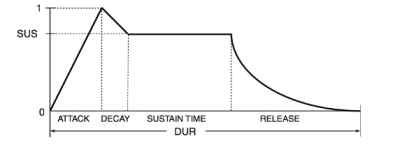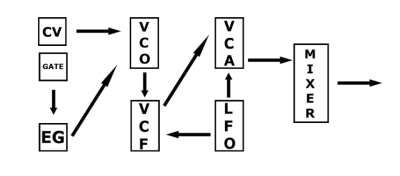What is modular synthesis?
Modular Synthesis is a group of specialized modules that are connected together
via patch cords in order to create a “patch”. Unlike most “keyboard synthesizers”, Modular
synthesizers have no hard-wired architecture and can be patched in almost limitless ways
to achieve the specific goals of the musician. Both audio signals and voltage signals can be
used to affect modules.
Why should I care?
-Full hands on control
-True freedom on how you put a synthesizer together
-You get to play with knobs, switches, cables, and other visceral items.
-Discover new sounds through experimentation
What are these “modules” ?
Since there are so many different modules at this point, let’s start with the basics.
In order to get any noise at all from your modular synthesizer you will need at least:
1. Control Signal(s) either in voltage (which we will now call CV or Control Voltage) or audio.
2. Voltage Controlled Oscillator(s) or VCO
3. Amplifier
These three modules are ‘essential’ however, in order to get at even some basic meat, we
should add these as well:
4. Gate(s) or trigger
5. Voltage Controlled Amplifier or VCA
6. Voltage Controlled Filter or VCF
7. Low Frequency Oscillator or LFO
8. Envelope Generator EG or ADSR
9. Mixer
What do each of these modules do?
Since we will have no sound at all unless we have these, lets start here:
Control Voltage or CV can be generated in many ways. Most commonly you can get CV by
a CV keyboard or keyboard that has MIDI out (you will have to put this into MIDI to CV
Converter). You can also use a sequencer or even another module that produces CV.
When connected to a VCO, CV produces pitch from your VCO. There a few widely recognized
standards on how the amount of voltage correlates to a specific pitch, but for this brief
intro we will stick with how Dr. Bob Moog set it up in the 1960’s. His standard is One Volt
Per Octave. Specific voltages equate to specific notes with a full volt between each octave.
For example, 1 Volts = A1, 2 volts = A2. Fractions therein equate to an infinite amount of
pitches. If your VCO is designed to take 1v/per octave and tuned properly, you will hear the
intended pitch if you provide the proper relative voltage.
VCO’s oscillate in various waveforms which sound different to the human ear. These
waveforms can also affect other modules in different ways. A square wave sounds harsher or
“mechanical”,is boxy and can signal on/off to other modules. A sine wave is smooth sounding.
The triangle wave is sonically similar to the square wave as it only contains only odd harmonics.
It is also put to good use in on/off functions. The sawtooth wave is also harsh and has a slow
rise and fast fall, or in reverse a fast rise and a slow fall. See examples below.:
If the CV tells the oscillator what the pitch is then the gate tells us if the pitch is either on or off. In modular synthesis there are normally two types of gates:
Voltage Trigger – Marked as V-Trig or just plain ‘ol GATE. The voltage it takes to trigger
a gate is usually between 3-5 positive volts and is the mot common type of gate trigger.
Switch Trigger – Marked as S-Trig was designed by Moog to switch to ground. This type of
trigger on a Moog and some other devices connects via a Jones Plug cable and is far less
common at this point.
Picture hitting a note on a keyboard. When you hit the key the specific note is played and
will play until you release your finger (well, depending on your envelope, instrument, etc.,
but just bear with me for now). Picture a Gate of Sound being opened by you hitting a key
and the Gate of Sound being closed to no longer allow sound to flow through it when you
release the key. This is the gate. It tells the VCO weather to emit sound or not. On/Off,
Open/Shut.
The last essential is the amplifier! You need some way of hearing the rad noise you are
making, so just like your electric guitar, you need to take the output on your VCO and plug it
into an amp in order to hear what you have made. Take a look below:
Let’s get a LITTLE DEEPER!
Pretty simple eh? Let’s now add some more modules and get to know them a bit.
Voltage Controlled Amplifier – or VCA is a module that varies its gain relative to the amount
of CV patched in. The voltage waveform greatly affects how this sounds. A warbling
tremolo effect can be achieved with a sine wave. Square waves can give an a stuttering
Tremolo effect.
Voltage Controlled Filter – or VCF is a module that attenuate high, low and band (both
high and low) frequencies of an input frequency (you can also select band reject to isolate a
specific band to affect). CV can affect the cutoff of specific frequencies and also vary the
resonance. Change in resonance basically means that some frequencies will be louder or quieter
and the timbre will change. There is much to read about resonance and filters in general. Some
knowledge of physics helps. Phaser like effects can be achieved through a VCF with LFO
modulating the cutoff.
Low Frequency Oscillator – or LFO – a Module used to modulate almost anything in your rig!
These low frequencies (sub-audible) are slow enough to modulate other frequencies on the
VCO, or can be sped up to just reach audible frequencies. Waveform selection is included on
most LFO’s. When a frequency modulates another frequency, Frequency Modulation or FM
is achieved.
Envelope Generator – or EG producing ADSR: Attack, Decay, Sustain, and Release.
This module takes the gate signal and modifies it from a simple on/off gate into a dynamic
gate. The EG produces a time event where the attack is how fast the frequency or signal is
allowed to rise in amplitude. The Decay is how much time it takes for the amplitude to fall
to its sustain level (how long the signal will stay at given amplitude) and the Release is how
much time the signal will take to drop back to zero. An example is pictured below.
Mixer – Well, if only one oscillator was being used in a rig, then you would not need a mixer.
As one is building their highly addictive setup, many VCO’s can be used at a time, as well as
other instruments being patched in to be modified. This requires a mixer to bring all that fun
noise together. Really a mixer in the modular synthesizer world is the same as any other. It
allows you to attenuate many sounds to the desired mix – ready for output to your desired
playback unit (headphones, amp, monitors, etc).
The Beginning – We are just getting started here, there is much to be said about Ring
Modulators, Sample and Hold Modules, Noise Generators, Multiples etc. I hope this is
enough to wet your appetite a bit. Below is one of thousands and thousands of patches.
Enjoy!









Nice to see support for Frac format. Recently, added quite a few Synthrotek builds to our Frac rig! I think we’ve shared a couple photos of our Synthrotek builds? Building all the time and actively demoing ;o) Keep us in the loop on updates and please consider us for beta testing.
Feel free to join our new Frac Rack facebook page… We’ll gladly post Synthrotek products!
https://www.facebook.com/pages/Frac-Rack-Users/221539761320648
All my best, Sean Ober / dJ dAb
Free The Funk / Free Records
Solid Rate Studios
Thanks for the orders and support Sean, I will certainly keep you in mind. I have been look for some CAD .DWG drawings for the panels. I am happy to trade anyone who can help me with this.